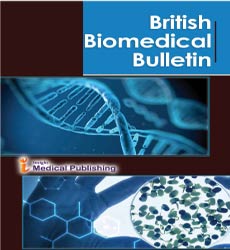ISSN : 2347-5447
British Biomedical Bulletin
Contributions of Bioinformatics Tools to the Study of cfDNA
Latifah Awe*
Department of Life Sciences, South Eastern Kenya University, Kenya
- *Corresponding Author:
- Latifah Awe
Department of Life Sciences, South Eastern Kenya University,
Kenya,
Email: latifah78@gmail.com
Received date: January 13, 2023, Manuscript No. IPBBB-23-15996; Editor assigned date: January 15, 2023, PreQC No. IPBBB-23-15996(PQ); Reviewed date: February 01, 2023, QC No IPBBB-23-15996; Revised date: February 07, 2023, Manuscript No. IPBBB-23-15996 (R); Published date: February 14, 2023, DOI: 10.36648/2347-5447.11.1.5
Citation: Awe L (2023) Contributions of Bioinformatics Tools to the Study of cfDNA . Br Biomed Bull Vol. 11 Iss No.1:005
Introduction
Cell-free DNA (cfDNA) may be useful for early disease diagnosis, prognosis evaluation, and efficacy monitoring as a novel non-invasive marker for molecular detection. Clinical studies on the use of cfDNA detection methods for patients have increased as a result of the constant advancements in molecular biology detection technologies. Numerous positive outcomes have been achieved. Endogenous DNA that has been released into plasma but remains unattached to cells is known as cell-free DNA (cfDNA). Chromosome nuclear DNA enters the bloodstream in the form of cfDNA as DNA fragments and nucleosomes during cell death instead of being encased in a membrane. cfDNA can be found in a variety of body fluids in humans, and its concentration changes in response to things like tissue damage, cancer, and inflammation, for instance. In the field of disease research, liquid biopsies using the cfDNA that circulated in body fluids have emerged as a hot topic.
Fragmentation for Locating Hotspots of cfDNA
Additionally, this group discovered that numerous short fragment sequences were formed in highly accessible chromatin regions in fetal cfDNA. According to Underhill et al., these findings suggested that plasma cfDNA degradation was more closely associated with chromatin accessibility than with cell death or the state of nucleosomes. Determined that melanoma patients had shorter plasma cfDNA fragments and higher plasma cfDNA concentrations than healthy controls. Plasma cfDNA fragments were also found to be small in the group of patients with systemic lupus erythematosus. Numerous studies have demonstrated that while normal nucleosome spacing exists in healthy individuals, morbid states exhibit some abnormalities. The sizes and distributions of plasma cfDNA in various morbid states varied, according to these findings. Rainer and co. studied the relationship between plasma cfDNA and cerebral stroke and discovered a positive correlation between prognosis, mortality, and Rankin scores in patients with cerebral stroke. These results suggested that the plasma concentration of cfDNA could be used to predict stroke mortality. In contrast to healthy controls, researchers at the Johns Hopkins University School of Medicine in Baltimore, Maryland, USA, recently discovered that the lengths of plasma cfDNA fragments in cancer patients varied significantly. With 98% specificity and 73% sensitivity, the researchers were able to predict whether a sample was from a cancer patient or a healthy control by utilizing the variance of the fragment lengths within a genomic interval of 5 Mb. In datasets containing patients with a variety of cancers, they achieved high sensitivity. Zhou and co. developed a method known as Cell Free DNA Fragmentation for locating hotspots of cfDNA fragmentation in plasma cfDNA sequencing data. These models were found to be very useful for predicting the onset and progression of cancer.
Development of Non-Invasive Diagnostic Methods for the Detection of Diseases
Urine cfDNA, in contrast to plasma cfDNA, originates primarily from the reproductive and urinary systems or through filtration in the kidney glomeruli. Urine cfDNA fragments, according to Phoenix Children's Hospital researchers, showed a strong correlation with the expression of genes in related tissues, in contrast to blood (plasma) cfDNA fragments. According to a few studies, this feature of urine cfDNA could be used to monitor patients after kidney transplants, diagnose kidney and bladder cancer, and monitor bacterial infections. As a result, urine cfDNA can be regarded as an excellent diagnostic marker. By extracting cfDNA from plasma or urine samples and carrying out genome sequencing, fragment feature analysis, and genome sequencing, it has the potential to significantly advance its use in the diagnosis of diseases and to generate significant research concepts for the discovery of disease biomarkers. Which primarily include the identification signals of cfDNA tissue sources, methods for identifying cfDNA, and connections between cfDNA and human cancer, end-stage kidney disease, and ischemic stroke? For the purposes of bioinformatics and disease research, the cfDNA that is released into the circulatory system by apoptotic cells in various tissues can offer a wealth of information. Mutation sites, cfDNA fragment pattern patterns, and methylation markers are the primary signals used to identify cfDNA tissue sources. Currently, imaging and cytopathology technologies are used to support the diagnosis of severe diseases, primarily by examining the clinical symptoms of the patient. Most of the time, techniques like computed tomography, ultrasonics, and magnetic resonance imaging are used. However, these methods require a lot of expensive and hard-to-use large equipment. Additionally, patients must be moved multiple times, which severely limits the scope of applications. Different tissues undergo apoptosis to generate plasma cfDNA. The foundation for the development of noninvasive diagnostic methods for the detection of diseases like cancer has been the study of cfDNA. As a non-invasive early screening tool, plasma methylation biomarkers of various cancers have been investigated, and liquid biopsy has expanded the possibilities for clinical investigations and the early detection of cancers.
Open Access Journals
- Aquaculture & Veterinary Science
- Chemistry & Chemical Sciences
- Clinical Sciences
- Engineering
- General Science
- Genetics & Molecular Biology
- Health Care & Nursing
- Immunology & Microbiology
- Materials Science
- Mathematics & Physics
- Medical Sciences
- Neurology & Psychiatry
- Oncology & Cancer Science
- Pharmaceutical Sciences
